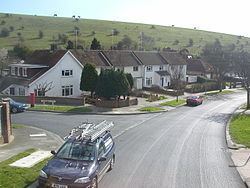Population 9,793 (2011.Ward) Region South East Police Sussex Dialling code 01273 Postcode district BN2 Post town Brighton | Unitary authority Country England Fire East Sussex Sovereign state United Kingdom Ceremonial county East Sussex UK parliament constituency Brighton Kemptown | |
 | ||
Restaurants Wooding Fish Bar, King Of India, Piazza, Mings, Uncle Sam's hamburg | ||
Woodingdean is an eastern suburb of the city of Brighton and Hove, East Sussex, separated from the main part of the city by downland and the Brighton Racecourse.
Contents
Map of Woodingdean, Brighton, UK
Source of name
The place takes its name from a former farm at the southern end of the modern suburb, whose main claims to fame are to have been owned by the comedian Max Miller and used as a wartime retreat by the former emperor of Ethiopia, Haile Selassie. The site of the main house is now Ovingdean Close, Ovingdean, and converted farm buildings remain in Ovingdean Road.
Beginnings
The earliest buildings in Woodingdean apart from scattered farm buildings were those of the former workhouse school in Warren Road, whose site is now a private hospital - The Nuffield. This contains the capped site of what is still, after 150 years, claimed to be the deepest hand-dug well in the world. Hand-dug between 1858 and 1862, its depth is 1,285 feet (392 m).
Woodingdean in its present form began to grow up after the First World War in the northern part of the parish of Rottingdean. It consisted of plots of land on the South Downs which had formerly been used for sheep-farming. These were sold by developers (often but not exclusively to returning soldiers) and most were originally smallholdings, e.g. poultry farms.
Development
The development of the present residential area very much mirrors that of neighbouring Ovingdean. From the 1920s building plots were sold off and first generation shacks and houses began to appear. The area was once locally notorious, like nearby Peacehaven, for the shacks that were put up on these plots, whose architectural styles ranged from Wooden Hut to Railway Carriage Body. Life in these plotlands was satirized in a stage play by H. F. Maltby called What Might Happen (1927). In 1928, both Woodingdean and Ovingdean became part of Brighton County Borough, a move which heralded a substantial increase in residential development.
The area was extensively developed during the 1950s and 1960s when most of the roads in the north-eastern and southern ends of the village were built, including North Woodingdean and South Woodingdean Council estates, which give Woodingdean its distinctive layout - a kidney shaped suburb with private estates in the middle, and a layer of council housing round the edge backing on to the open Downs. There was also a small industrial estate at the north-western end, just off Falmer Road next to the North Woodingdean Estate. The main buildings were the Jaycee Furniture factory and Sunblest Bakery, closed in the 1990s and demolished in 2002.
Today
The area has a population in excess of 10,000 but despite its size still has some attributes of a village, including two sets of shops. Woodingdean today has dynamic social and religious communities of clubs, associations and organisations which also include sports and leisure facilities. There are two primary schools, Woodingdean Primary and Rudyard Kipling, and a special school, Downs View. There are places of worship for Anglicans, Methodists, Baptists, Christadelphians, Plymouth Brethren, Roman Catholics and Jehovah's Witnesses. There are two pubs, the Downs Hotel in North Woodingdean, and the Toby (closed down) in South Woodingdean. North Woodingdean is the highest part of Brighton and Hove above sea-level.
